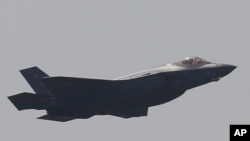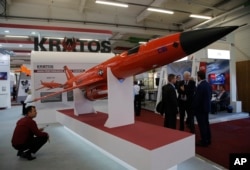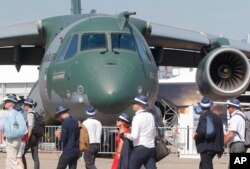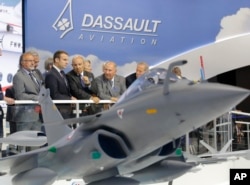Military conflicts and growing threats around the world continue to underpin demand for weapons, but industry and government leaders from the United States, Europe, Russia and the Middle East say they don't see a huge near-term spike in arms orders.
Executives report being busier than ever at this year's Paris Airshow, the oldest and biggest aerospace expo in the world, which featured aerial acrobatics by Lockheed Martin Corp.'s F-35 fighter jet.
But they caution that foreign arms sales take years to complete, and NATO governments must get through lengthy budget and bureaucratic processes before they can raise military spending to meet a NATO target for members to spend 2 percent of gross domestic product (GDP) on defense.
No big spurt seen
"We're seeing some growth, but I like to be pragmatic. I'm not seeing a big tick up in defense spending across the board," Leanne Caret, who heads Boeing's defense business, told Reuters in an interview. Her division generates about 40 percent of its revenues overseas, a big change from just several years ago.
Boeing officials expect steady gains in weapons sales, but warn against expectations for any kind of "gold rush" despite U.S. President Donald Trump's pledge to boost military spending, saying there may be more of a shift in what platforms and weapons programs are in demand.
Recent increases in tensions between Russia and the United States have raised concerns about another arms race, but top officials in both countries agree that there will not be a mad rush to bulk up on weapons.
Moscow's top arms trade official, Dmitry Shugaev, told reporters at the show that Russian weapon makers remained competitive despite Western sanctions, but the cyclical nature of the business and budget constraints are dampening prospects for a big surge in global arms sales.
He also expressed skepticism that NATO members would rapidly increase their military budgets, despite pledging to move toward the 2 percent goal.
Trump position
Trump's public declarations that NATO members are not pulling their weight may have had some impact. Lockheed Martin's Aeronautics business leader, Orlando Carvalho, said national security budgets and military systems' demand outside the United States are beginning to increase, "especially with the focus that the president has put on NATO."
In 2016, total world military expenditure rose 0.4 percent to $1.69 trillion, according the Stockholm International Peace Research Institute (SIPRI).
The European Union's economic and financial affairs commissioner, Pierre Moscovici, also cited that risk, warning that European countries needed to match political pledges to boost military spending with actual resource commitments.
"There is now a window of opportunity for investing more in European defense ... but as with all windows, a window closes if you don't go through it," he said.
Gradual increases in Europe
Germany and other European countries are boosting military spending, concerned about terrorism and Russia's increasingly assertive military stance after its annexation of Crimea and its support for separatists in eastern Ukraine, but the increases are likely to be more gradual than dramatic.
In the missile defense arena, Western concerns about rapid advances in technology by North Korea, China and Iran, as well as Russia's increased military activities, are driving orders for a range of defensive systems, according to U.S. and European executives.
"The threat is absolutely increasing and it's increasing rapidly," said Tim Cahill, vice president of air and missile defense systems at Lockheed. "In every region around the world, the level of interest in integrated air and missile defense has been going up in the last few months."
Wes Kremer, president of Raytheon's Integrated Defense Systems, said he was meeting with officials from countries that had not shown any interest in missile defense systems just four or five years ago.
"Back then, they didn't see a ballistic missile threat, or they didn't see Russia as a threat, but now that has changed," he said.













